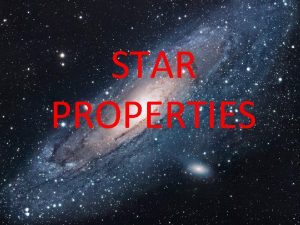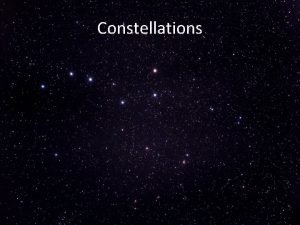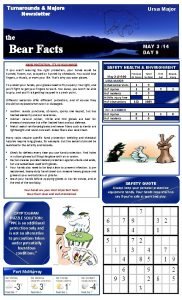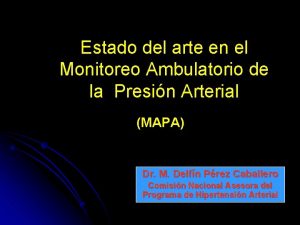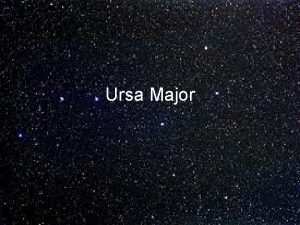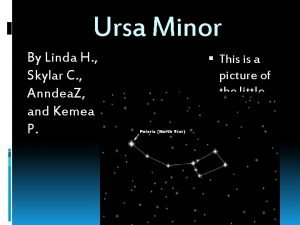STAR PROPERTIES Contelations Ursa Minor Little Dipper Ursa




























- Slides: 28

STAR PROPERTIES

Contelations • • • • • Ursa Minor (Little Dipper) Ursa Major (Big Dipper) Cassieopa Cepheus Draco Orion Bootes Capella Castor & Pollux (Gemini) Corona Borealis Saggitarius Hercules Fomahault (Pieces) Andromeda and Pegasus Lyra Cygnus Aquila Summer Triangle Delphinus • • Scorpius Canis Minor Canis Major Leo

How Many Stars in Orion? A. B. C. D. 25 8 100 >1, 000

How Many Stars in Leo? A. B. C. D. 25 16 100 >1, 000

How Many Stars in Ursa Major? A. B. C. D. 50 21 100 >1, 000

How Many Stars in Gemini? A. B. C. D. 15 21 100 >1, 000

Answers • • Orion >1, 000 Leo > 1, 000 Ursa Major >1, 000 Gemini >1, 000

Properties of Stars • Constellation – 88 total – More stars in constellation than found in pattern – Millions upon millions of stars in each

Properties of Stars - Distance • Parallax – basic way to measure distance – Stars positions appear to shift based on season – Smallest angle shift = farther away – Largest angle shift = closest


Properties of Stars - Distance • Measured in light-years – distance light travels in one year (9. 5 x 1012 or 9. 5 trillion kilometers) DISTANCE NOT TIME LIGHT-YEAR MEASURES • Astronomical unit (AU) – 1 AU is the distance between the Sun and Earth • Our closest star (other than the sun) is 4. 3 lightyears away.

Properties of Stars - Mass • Binary Stars - pairs of stars pulled together by each other’s gravity – Gravity pull determined by mass – The bigger the mass the greater the pull – Difference in center of masses allows calculations of both star masses – About 85% of the single points of light we observe in the night sky are actually two or more stars orbiting together. (in the Milky Way)


Types of Binary Stars • Wide binaries – stars evolve separately • Close binaries – transfer mass, sometimes can consume the other • Visual binaries – far enough apart to view both stars (5 -10%) • Spectroscopic binaries – appear close, must study wavelengths to study • Eclipsing binaries – orbits cause eclipse from Earth • Astrometric binaries – companion star cannot be identified • Double stars – appear close, but aren’t

Which Flame?

Properties of Stars - Temperature • A star’s color tells us about its temperature! – Blue = very hot (30, 000 K) – Yellow = medium (5, 000 K) – Red = cool (2, 000 K) Hottest – Blue – White – Yellow – Orange – Red Coolest K = Kelvin, a type of temperature. K = °C +273

Properties of Stars – Temperature cont. • Different colors based on energy emitted – More energy shorter wavelength = blue – Less energy longer wavelength = red

Properties of Stars - Brightness • Apparent Magnitude: brightness of a star as it looks from Earth – Depends on how big it is, how hot it is, and how far away it is. • Absolute Magnitude: how bright a star actually is from 32. 6 light years away – Based on distance away – abs. mag. Sun = 5 – less than 5 brighter than Sun – Greater than 5 dimmer than Sun • Negative numbers mean that the star is very bright!!!

Properties of Stars – Brightness cont. • Luminosity is the measure of the energy output from the surface of a star per second. • This is based on the star’s apparent magnitude and how far away it is. • Sun = 3. 85 x 1026 Watts = 3. 85 x 1024 W 100 W lightbulbs! • No stellar property varies by so much! – From. 0001 to more than a million times the Sun’s

Check for Understanding: • If I compare the brightness of two stars from where I am standing on Earth, am I using apparent or absolute magnitude? • What color of star is the hottest? • What are common units of distance when talking about astronomy?

Hertzsprung-Russell Diagram

HR Diagram

Hertzsprung-Russell Diagram Hottest Stars: On the left side Brightest Stars: At the top Biggest stars? Giants and Supergiants Smallest stars? White dwarfs

Stars fluctuate in brightness – Variable Stars • Pulsate in brightness because of the expansion and contraction of their outer layers • Cepheid stars – get brighter and fainter in a regular pattern – Comparable to a street lamp – Longer periods – larger absolute magnitude – Distance can be measured by comparing the absolute magnitude and the apparent magnitude. • Nova – sudden brightening of a star (white dwarf) – Small amount of mass lost during surge – Due to energy transfer in binary stars from bigger to smaller star

Nebulae • Clouds of dust and gas – Mostly hydrogen – Absorb UV light – Reflected nebulae – reflect light from near star – Dark nebulae – not very dense, but more mass than sun



Recap • 1. What are some properties of stars we discussed? Explain each. • 2. Why do astronomers use parallax? Describe the process. • 3. Compare and contrast apparent and absolute magnitude. • 4. What does an HR Diagram tell astronomers? What are the axes labeled?
 Orion the hunter constellation
Orion the hunter constellation Major arc geometry
Major arc geometry Otto frank and van daan traded in
Otto frank and van daan traded in Contelations
Contelations Bearing gifts we traverse afar
Bearing gifts we traverse afar 1 little 2 little 3 little indians
1 little 2 little 3 little indians 1 little 2 little 3 little indian
1 little 2 little 3 little indian Ursa major facts
Ursa major facts Ursa gummus
Ursa gummus Ursa major facts
Ursa major facts Mapa valores normales
Mapa valores normales Jolly dipper menu
Jolly dipper menu Whats a bucket dipper
Whats a bucket dipper Conservewell dipper well
Conservewell dipper well Big dipper
Big dipper Profilo pressorio dipper
Profilo pressorio dipper Sistem simplu nedeterminat
Sistem simplu nedeterminat Difference between a star and ao star
Difference between a star and ao star Fccla star stands for
Fccla star stands for F f# g g# a a#
F f# g g# a a# Twinkle little star korean
Twinkle little star korean Twinkle twinkle little star figurative language
Twinkle twinkle little star figurative language Way down south where bananas grow
Way down south where bananas grow The rhyme scheme
The rhyme scheme Twinkle twinkle little star piani
Twinkle twinkle little star piani Wrinkle little star
Wrinkle little star Alliteration of fleet
Alliteration of fleet Limerick there once was an ape in a zoo
Limerick there once was an ape in a zoo Aka.msconnect
Aka.msconnect



